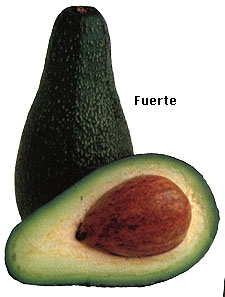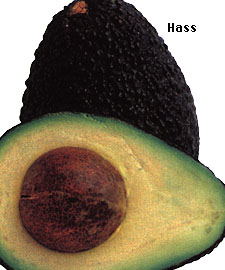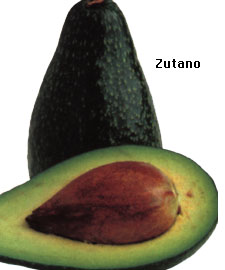



FoodFood InformationVegetables
The avocado is a tropical fruit native to Central America. Early in the
sixteenth century it was introduced to Europe by the returning Spanish explorers.
Today, avocados are grown in all areas of the world that have frost-free
climates similar to that of their original habitat.
The United States is the world's number one commercial producer of avocados.
It is a major cash crop in Southern California and southern Florida, and
to a much lesser degree in Texas. California has the lion's share of the
production, about 80 percent, and their avocados are available twelve months
of the year. The Florida avocados have an eight month season. They are not
available during the months of March, April, May, and June. Whether your
local supermarket offers California or Florida (or both) avocados depends
on the time of year and your geographical location.
The avocado has a unique flavor and texture. All the other tree fruits have
either a tart, tart-sweet, or sweet flavor and a juicy texture. The avocado
has a bland flavor and a buttery texture. The avocado looks like a huge
green olive and, like the olive, has a single hard pit. It is very firm
when immature and is rich in oil when it reaches full ripeness.
There are at least two dozen varieties of avocados grown commercially in
the United States. They come in assorted sizes and shapes. One California
avocado is petite, weighing only a few ounces, while some Florida varieties
can weigh as much as three pounds.
Depending on the variety, the immature fruit comes in every possible shade
of green. Some are smooth and shiny, others are dull and have pebble-grained
skins. Some varieties retain their original green color as they ripen. In
others, as the fruit ripens the green changes to bronze reddish purple,
or even jet-black. Some varieties are almost round, but for the most part
avocados are pear-shaped. Hence they are often called avocado pears.
Nearly all other tree fruits have to be harvested at a certain point of
maturity lest they get too ripe to ship to market or even for immediate
consumption. However, the avocado never reaches full maturity unless
it is severed from the tree. In some California varieties the harvest can
be delayed for months on end without affecting the flavor or the quality
of the fruit. This ability to warehouse the fruit right on the tree is a
boon to the growers because it provides for an orderly flow to market and
extends the length of the season.
There are two distinct strains of avocados. The varieties grown in California
are offshoots of the original Mexican and Guatemalan avocados. Those grown
in Florida are derived from the West Indian avocados. Since the soil, amount
of moisture, and climate of Southern California differ from that of southern
Florida, the varieties that thrive on the West Coast don't do nearly as
well on the East Coast, and vice versa.
While the avocado from either area is a quality product, there are significant
differences in size, texture, and flavor. The Florida avocados offer advantages
in size and often in price. They are usually at least twice as big as those
from California and nearly always less costly. The smaller, costlier California
avocados have more of the desired nut like flavor and a richer, creamier
texture than the more watery Florida fruit. A California avocado is to a
Florida avocado as ice cream is to ice milk. However, if you prefer ice
milk, you may also prefer the Florida avocado because of its lower calorie
count.
At full ripeness, the California avocado is not quite as perishable as the
fully ripened Florida fruit. A very ripe, unbruised California avocado usually
cuts fine and shows no discoloration. A very ripe, unbruised Florida avocado
sometimes cuts dark.
Until very recently, avocados sold at the retail produce counters were always
very firm. The newest wrinkle in marketing avocados is to offer those that
are ripe and ready to serve, a concept that has been promoted by the California
Avocado Commission. Participating retailers, including most of the major
retail food chains, report significant increases in sales. However, there
is probably a comparable increase in the number of bruised, discolored,
and even black avocados that have ended up in consumers' garbage cans.
I advise against the purchase of ready to serve avocados because the ripe
fruit is far too fragile to survive the rigors of a self-service method
of marketing. They are too often thumbed and squeezed until they are badly
bruised by well-meaning but overzealous shoppers. The bruised area of an
avocado will discolor and have to be cut away.
I recommend purchasing firm avocados and ripening them at home by leaving
them at room temperature for a few days. If you want to speed up
the ripening process, put the avocado in a brown paper bag along with a
fresh tomato and put the bag in the warmest area of your home. This combination
of warmth and the natural ethylene gas exuded by the avocado, and especially
by the tomato, could cut the ripening time in half.
To test for ripeness, cradle the avocado in the palm of your hand. If it
yields to the slightest and gentlest pressure, it is ready to serve, if
it is a Florida avocado. If it is of the California variety, give it an
extra day. Too many avocados are cut and served before they have reached
full maturity and flavor. Once the fruit is cut, the ripening process is
terminated. So make sure that it does have the slight yield before you cut
it.
Avocados are not only flavorful, colorful, and nutritious but are also blessed
with versatility. They can be sliced, diced, pureed, or served on the half-shell.
They are flavorful enough to serve alone, but they also blend well when
served with fresh fruit, salad greens, cottage cheese, cold meats, and especially
seafood. A fully ripe avocado has the consistency of soft butter and makes
a delicious and colorful sandwich spread. The increase in the popularity
of Mexican foods has increased the usage of avocados. Their bland flavor
helps take the sting out of the fiery dishes.
A cut avocado, like a sliced peach or banana, will darken and discolor when
exposed to air. Sprinkling the exposed surfaces with fresh lemon or lime
juice will retard this discoloration. Try to use a cut avocado as soon as
possible. In the interim, cover the exposed surfaces with plastic film.
If you cut the avocado in half, don't remove the pit until ready to serve.
Avocados are tropical fruits and don't like cool temperatures. Never put
a firm avocado in your refrigerator. At best it won't ripen properly, at
worst its flesh will turn black. A black-skinned avocado, however, is a
hallmark of quality. The California Hass variety is an ugly duckling that
has a dull, pebble-grained green skin when it is immature. As it ripens,
the color of the skin turns to jet-black. This least attractive variety
is by far the finest-flavored avocado available. When you see this Hass
variety, remember that its ugliness is only skin-deep.
Never freeze a whole or cut avocado, but avocado puree may be frozen. Even
though there are many recipes that call for cooking avocados, the peak flavor
and texture can only be found in the raw fruit.
Before World War II, the avocado was sold only in elite fruit shops at costly
prices. Today it can be found in most supermarkets, selling at moderate
prices. Annual increases in acreage and crop yield allow ample supplies
and even more modest prices.




Deamer 5/97